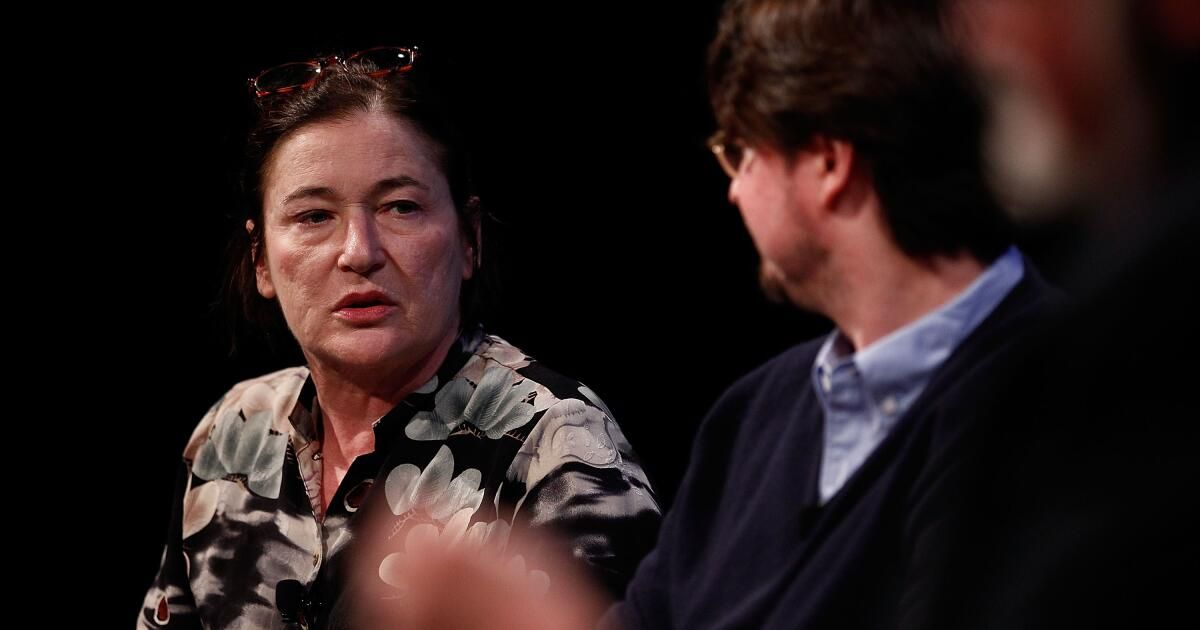Book Review
The bloody nightgown and other essays
By Joan Acocella
Farrar, Straus and Giroux, 368 pages, $35
If you buy books linked to on our site, The Times may earn a commission from Bookshop.org, whose fees support independent bookstores.
“I guess I know a hot dog from a real artist.” Joan Acocella modestly observed last year. Few would disagree. Watching her tell them apart, with an occasional burst of her wild wit, was a delight for readers for four decades. Unfortunately, the publication of her new collection, “The Bloody Nightgown and Other Essays,” comes just a few weeks later. his death on January 7 at 78 years old. Bringing together some of his most intelligent and entertaining pieces on literature and language published between 2007 and 2021, the volume must now serve as an improvised monument to Acocella's career.
Many knew her best for her writing on dance (she was the New Yorker's dance critic for more than 20 years), but “The Bloodied Nightgown” is set offstage, in the library. Acocella was a cultural omnivore and the menu here is correspondingly eclectic: Dracula, dictionaries, bad words; Marilynne Robinson, Richard Pryor, Elena Ferrante; Gilgamesh, Beowulf, “Little Women.” The book's 24 pieces offer not only an inventory of Acocella's interests but also shining examples of what made her a pleasure to read.
I spoke to half a dozen people who knew and worked with Acocella to get a sense of how she approached the art of criticism and her development as a writer. They remembered a warm, gossipy, hard-working, impatient, sociable, kind woman who told jokes, took her friends to dance shows, knew what she thought and remained faithful – until the end – to the fax machine.
She first encountered her people – “people without tans, people who went to flute concerts,” as she described them – in Berkeley, in her native California. While she was studying there, she spent a third year in Padua. (Her work would later include many Italian artists, including, in “The Bloody Nightgown,” Ferrante, Natalia Ginzburg and Gianni Rodari). When she was 20, she got married and moved to the East Coast; When she was 30, she earned a doctorate in comparative literature. The doctorate turned out to be invaluable training, although not for an academic life.
“It would have been difficult for me” Acocella once said, “to navigate the culture wars at the university.” This statement partly reflects, perhaps, his intolerance of intellectual dogmatism. For her, it was essential to keep the artwork free of ideological notions, firmly in the spotlight; This belief is at the center of her monograph on “Willa Cather and the Politics of Criticism.” Writing about the book of Job in “The Bloody Nightgown,” he chides author Mark Larrimore for the way he indulges the cruelest interpretations that writers of all time have imposed on Job: “Eventually he comes to seem anti-intellectual. At times, Larrimore sounds like a kindly Unitarian minister, or like Mr. Rogers.”
(Farrar, Straus and Giroux)
A touch as light as hers belies the sleepless nights it took him to acquire it. Acocella's thoroughness remained behind the scenes. Her compactness is a hallmark of her writing, made possible by both her hard work and her gifts for exposition and exegesis, which allowed her to digest and repackage enormous amounts of material. For “The Queen of Crime,” she read all 66 of Agatha Christie's crime novels (successfully guessing only two of the culprits). In fact, she often read dozens of books for a single piece and then mailed a trunk full of volumes, still smelling of cigarette smoke, to the New Yorker's fact-checking department. While researching her (sadly abandoned) book on Baryshnikov, she asked the New York Public Library for the Performing Arts: Where are your papers kept?, if you could send the entire file to your apartment. The request, understandably, was denied.
All of this work gave Acocella the ability and license to distill and make great judgments even within the restrictive word count of a review or magazine article. “[He] I was seventy years old when out of sight was published,” he wrote of Elmore Leonard. “He wrote thirteen more novels. “They were all overrated.” If this seems harsh, he continues: “Not all of Leonard's books are in [the level of Out of Sight], but five or six of them are, plus parts of many others. That's a lot.” It is the last line of the piece and characteristic of its concise and unsentimental generosity.
She was good at endings. Especially poignant in her light are the moments in which she uses the death of a subject as a moment to distill an essential truth, sometimes beautiful, sometimes tragic, about her life. Of Bela Lugosi, after his breakout role in “Dracula,” she wrote: “Thereafter, this ambitious Hungarian actor had difficulty landing roles that were not monstrous. He spent many years as a drug addict. He was buried with his Dracula cape.” Twenty-five years in three sentences, the pathos all in the economy. When Francis Bacon, an artist who (despite his name) had a lifelong fascination with viscera and carnage, died at 82, he remarked with more tenderness than may immediately appear: “At last It was meat.”
For Acocella, the biographies of artists are usually inseparable from their work. “I couldn't do without life,” he admits in the introduction to “The Bloodied Nightgown.” This may be due in part to the early success of her career as an editor at Random House, where she wrote, with two co-authors, a textbook on abnormal psychology. (The book went through so many updated editions that she was able to use the proceeds from her reviews to support her first forays into the less lucrative field of dance criticism.)
Psychology may not have been his chosen subject, but Acocella used what he learned. She surely complemented her interest in Vaslav Nijinsky, whose dance career was cut short by a diagnosis of schizophrenia (and whose uncensored letters she edited for publication). She may also have reported the psychological care she provided to his subjects. In writing about Louisa May Alcott's later work, for example, she draws a clear line between Alcott's poor health and the tiredness she perceives in the text. “Jo's Boys,” she wrote, “is actually a chore to read. Alcott tries to generate some excitement (there's a shipwreck, an explosion in a mine), but she can feel how bored she is and how much she wants to go upstairs and take a nap.”
The biographical material of “The Bloody Nightgown” serves not only as context but also as information of interest in itself. He did not know that, late in his life, the Brothers Grimm worked on definitions of A. to F for a major German dictionary. He also didn't know much about JR Ackerley's relationship with his dog Queenie, although what I know now can hardly be published in a family publication. Acocella's gift for acidic summaries vivified even an artist's CV: of Graham Greene's approach to his freelance work, which encompassed both magazine articles and intelligence gathering for MI6, he wrote: “Basically, every time An organization needed someone to go, the expenses were paid, to a country that had crocodiles, I was interested.”
Acocella's work was often in service of the art he loved and wanted to share. “Emotion” and its kin occur frequently. She can tell that she is having fun. (On evil stepmothers: “These women at least have some common sense, unlike the little Barbies they are trying to eliminate.”) The fantastic article on swearing, most of which cannot be cited here, is a delightful exercise in restraint and selective liberation. As she says: “When you drop your shopping bag in a puddle or slam the window shut with your finger, 'damn, Louise' isn't going to help you much.”
At one point, Acocella considered calling this final collection “Book Reports,” a sign, perhaps, of his no-nonsense professionalism. But this would not have adequately described the character without gloves – the joy! – with which she wrote. “The Bloodied Nightgown” shows that with age she became funnier, snappier, and spicier. May it be read for a long time.
Charles Arrowsmith is based in New York and writes about books, movies, and music.












